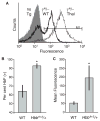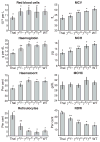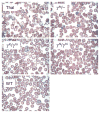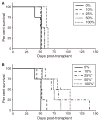Effects of human gamma-globin in murine beta-thalassaemia
- PMID: 16803575
- PMCID: PMC2811697
- DOI: 10.1111/j.1365-2141.2006.06102.x
Effects of human gamma-globin in murine beta-thalassaemia
Abstract
Murine models of beta-thalassaemia have been used to test therapeutic globin gene vectors. However, the level of gamma-globin expression necessary to achieve full phenotypic correction in these models is unclear. In order to address this issue, we carried out breeding and transplantation studies in murine models of beta-thalassaemia intermedia (Hbb(th-3)/+) and severe beta-thalassaemia major (Hbb(th-3)/Hbb(th-3)) using transgenic lines expressing various levels of human gamma-globin. Expression of gamma-globin RNA at a modest 7-14% of total alpha-globin RNA resulted in the selective survival of HbF(+) erythrocytes, a fivefold increase in total HbF, and a phenotypic improvement in the beta-thalassaemia intermedia model. Full normalisation of erythrocyte indices in this model required gamma-globin RNA expression at 27% of alpha-globin, resulting in an average 40% (6.8 g/dl) HbF. Studies using the homozygous Hbb(th-3) model of lethal beta-thalassaemia major demonstrated that even this high level of gamma-globin expression, for reasons related to the function of the hybrid globin tetramers, could only prolong, but not fully support, survival. Taken together, these results indicate that only the heterozygous Hbb(th-3) model of beta-thalassaemia intermedia can be reliably used for the pre-clinical assessment of gamma-globin gene therapy vectors, as well as other means of gamma-globin gene induction.
Figures






Similar articles
-
The degree of phenotypic correction of murine beta -thalassemia intermedia following lentiviral-mediated transfer of a human gamma-globin gene is influenced by chromosomal position effects and vector copy number.Blood. 2003 Mar 15;101(6):2175-83. doi: 10.1182/blood-2002-07-2211. Epub 2002 Oct 31. Blood. 2003. PMID: 12411297
-
The role of heterocellular hereditary persistence of fetal haemoglobin in beta(0)-thalassaemia intermedia.Br J Haematol. 2001 Sep;114(4):899-906. doi: 10.1046/j.1365-2141.2001.03042.x. Br J Haematol. 2001. PMID: 11564083
-
α-Haemoglobin stabilising protein expression is influenced by mean cell haemoglobin and HbF levels in HbE/β-thalassaemia individuals.Blood Cells Mol Dis. 2012 Jan 15;48(1):17-21. doi: 10.1016/j.bcmd.2011.10.002. Epub 2011 Nov 12. Blood Cells Mol Dis. 2012. PMID: 22079025
-
The Novel Role of the B-Cell Lymphoma/Leukemia 11A (BCL11A) Gene in β-Thalassaemia Treatment.Cardiovasc Hematol Disord Drug Targets. 2023;22(4):226-236. doi: 10.2174/1871529X23666230123140926. Cardiovasc Hematol Disord Drug Targets. 2023. PMID: 36734897 Review.
-
Globin gene expression in hereditary persistence of fetal haemoglobin and (delta beta) (0)-thalassaemia.Oxf Surv Eukaryot Genes. 1988;5:163-203. Oxf Surv Eukaryot Genes. 1988. PMID: 2472152 Review.
Cited by
-
Pluripotent stem cells in research and treatment of hemoglobinopathies.Cold Spring Harb Perspect Med. 2012 Apr;2(4):a011841. doi: 10.1101/cshperspect.a011841. Cold Spring Harb Perspect Med. 2012. PMID: 22474618 Free PMC article. Review.
-
Humanized Mouse Model of Cooley's Anemia.J Biol Chem. 2009 Feb 20;284(8):4889-96. doi: 10.1074/jbc.M805681200. Epub 2008 Dec 19. J Biol Chem. 2009. PMID: 19098001 Free PMC article.
-
Animal models of β-hemoglobinopathies: utility and limitations.J Blood Med. 2016 Nov 4;7:263-274. doi: 10.2147/JBM.S87955. eCollection 2016. J Blood Med. 2016. PMID: 27853395 Free PMC article. Review.
-
Recent trends in the gene therapy of β-thalassemia.J Blood Med. 2015 Feb 19;6:69-85. doi: 10.2147/JBM.S46256. eCollection 2015. J Blood Med. 2015. PMID: 25737641 Free PMC article. Review.
-
In vivo hematopoietic stem cell gene therapy ameliorates murine thalassemia intermedia.J Clin Invest. 2019 Feb 1;129(2):598-615. doi: 10.1172/JCI122836. Epub 2018 Dec 18. J Clin Invest. 2019. PMID: 30422819 Free PMC article.
References
-
- Antonchuck J, Hyland CD, Hilton DJ, Alexander WS. Synergistic effects of erythropoiesis, thrombopoiesis, and stem cell competitiveness in mice deficient in thrombopoietin and steel factor receptors. Blood. 2004;104:1306–1313. - PubMed
-
- Charache S, Clegg JB, Weatherall DJ. The negro variety of hereditary persistence of fetal haemoglobin is a mild form of thalassaemia. British Journal of Haematology. 1976;34:527–534. - PubMed
-
- Constantoulakis P, Josephson B, Mangahas L, Papayannopoulou T, Enver T, Costantini F, Stamatoyannopoulos G. Locus control region – a gamma transgenic mice: a new model for studying the induction of fetal hemoglobin in the adult. Blood. 1991;77:1326–1333. - PubMed
-
- Davis BH, Ornvold K, Bigelow NC. Flow cytometric reticulocyte maturity index: a useful laboratory parameter of erythropoietic activity in anemia. Cytometry. 1995;22:35–39. - PubMed
Publication types
MeSH terms
Substances
Grants and funding
LinkOut - more resources
Full Text Sources
Molecular Biology Databases

